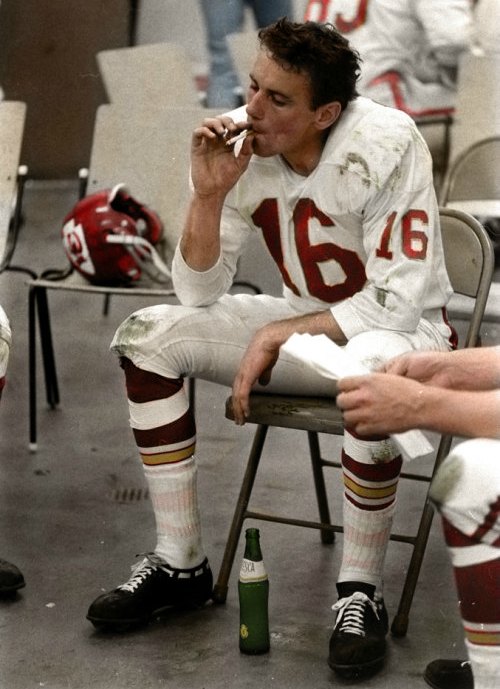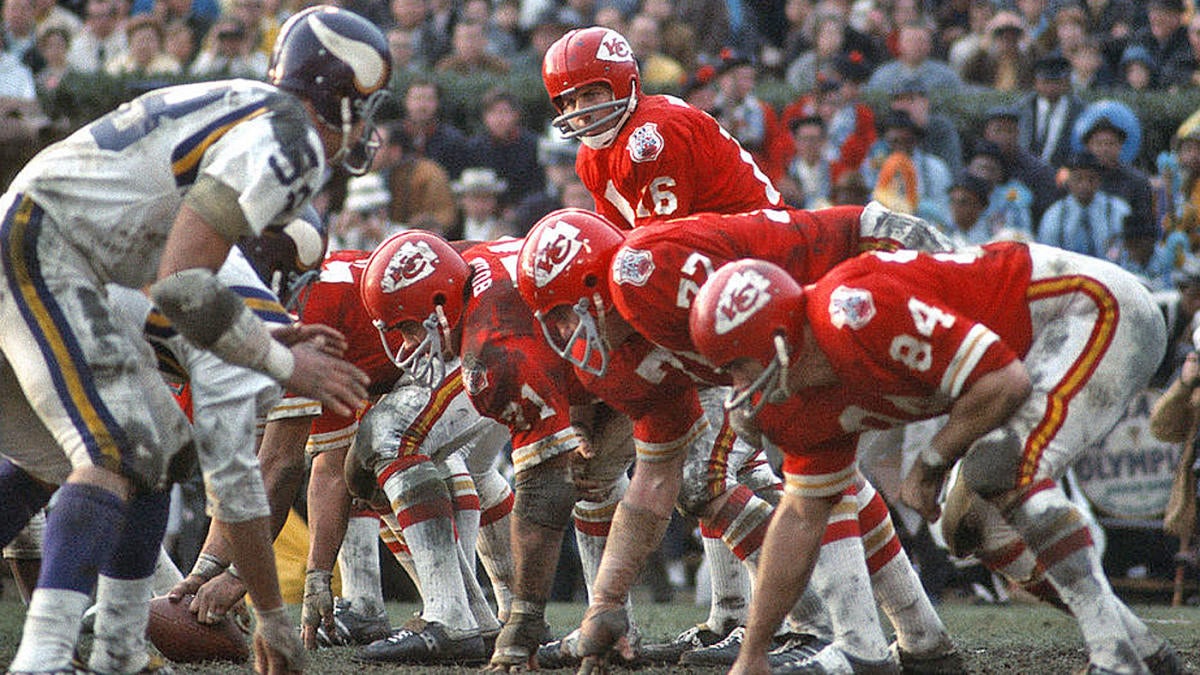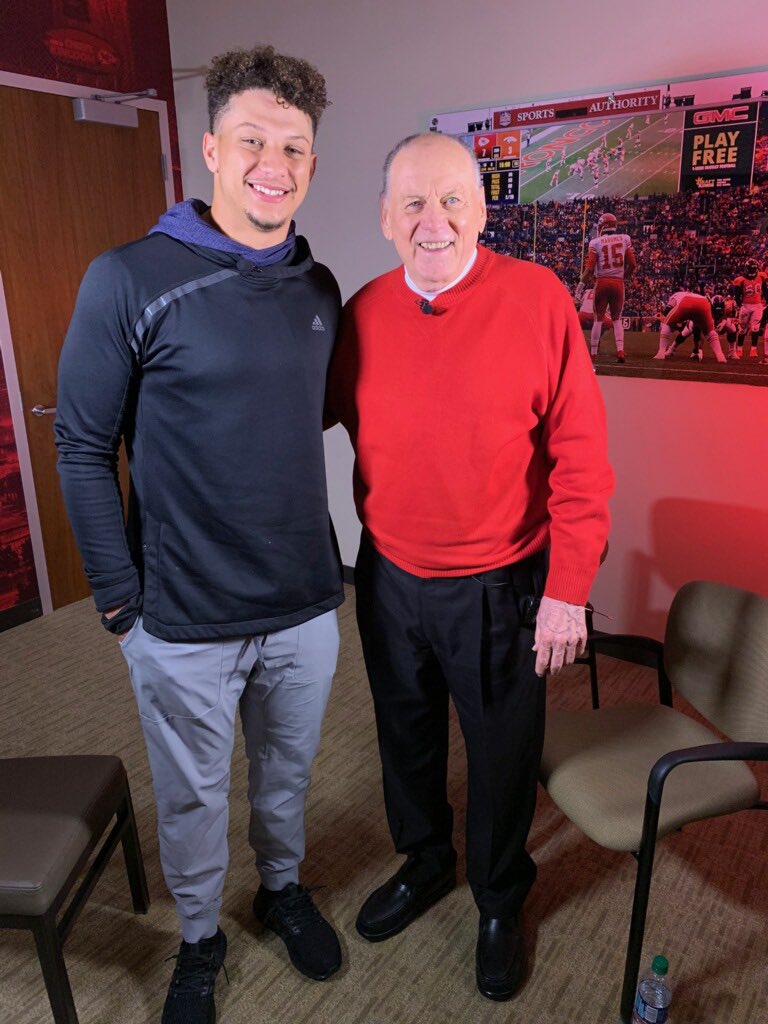Everyone considers the performance of Joe Namath in Super Bowl III, leading the New York Jets to victory after predicting it, to be one of the biggest moments in the history of professional football.
The performance of Len Dawson in Super Bowl IV the following season should not be overlooked.
Leonard Ray Dawson was born on June 20, 1935 in Alliance, Ohio, as the seventh son of a seventh son, a distinction that folklore says means one has special abilities. In spite of this, Len never wore Number 7 during his playing career, always Number 16.
Alliance is about 50 miles southeast of Cleveland, and 16 miles northeast of Canton, where the Pro Football Hall of Fame would be built. After starring at quarterback for Alliance High School, he was recruited by 2 Big Ten Conference schools, Ohio State and Purdue.
He knew that Ohio State head coach Woody Hayes didn't like to throw the ball. With some irony, Purdue's head coach, Stu Holcomb, had played at Ohio State, albeit 20 years before Hayes got there. He sent one of his assistants to talk to Dawson about the school, in West Lafayette, Indiana, about halfway between Chicago and Indianapolis, and its program. That assistant coach was Hank Stram, and thus began a friendship that lasted for the rest of Stram's life.
In 1954, as a sophomore, Dawson became Purdue's starting quarterback. While he wasn't the first Boilermaker signal-caller to be nicknamed "The Golden Boy" -- Bob DeMoss, later the school's longtime athletic director, had that honor -- he set the standard by which so many Purdue quarterbacks would be measured, including Bob Griese, who joined Dawson in the Pro Football Hall of Fame; and Drew Brees, who almost certainly will.
In that 1954 season, Dawson led the NCAA in passing efficiency, and also played defensive back and placekicker. In his 1st 2 games, he threw 4 touchdowns passes in a win over Missouri, then made the cross-State journey to South Bend, Indiana, and beat Notre Dame, 27-14. The Fighting Irish had come in as defending National Champions, ranked Number 1 in the country, and had a 13-game winning streak. They had a pretty good sophomore quarterback of their own, also known as the Golden Boy: Paul Hornung. (Both Purdue and Notre Dame have traditionally worn gold helmets.)
Also in 1954, Dawson was married to his high school sweetheart, Jackie, and they remained married until her death in 1978. They had a daughter, Lisa Ann; and a son, Len Jr.
In 1956, his senior year, Dawson would again lead Purdue into South Bend and upset Notre Dame, 28-14. The team as a whole wasn't that good, though, although the defensive line did feature future Los Angeles Rams star Lamar Lundy. Overall, though, the team's record in his 3 seasons was 13-10-4; they finished 6th, 4th and 7th in the Big Ten; and, as a result of the league's rule that only its Champion (or, if the Champion had gone the previous season, the 2nd-place finisher) could go to a bowl game, specifically the Rose Bowl, the Boilermakers didn't play in one.
*
The Pittsburgh Steelers drafted Dawson in the 1st Round of the 1957 NFL Draft. But after just 1 season, they acquired Bobby Layne, who had led the Detroit Lions to 3 NFL Championships and 1 other NFL Championship Game in the preceding 5 seasons.
Everyone who knew Steelers founding owner Art Rooney seemed to love him, but the man was a better administrator and a better fan than he was a football talent evaluator. In the 1950s, the Steelers had these quarterbacks in their camp: Len Dawson, Bobby Layne, Jack Kemp and Johnny Unitas. And they didn't make the Playoffs until 1972, with Terry Bradshaw.
Rooney traded Dawson to the Cleveland Browns. With Paul Brown as head coached, he should have thrived. (Should that be "thrived" or "throve"?) But Brown preferred starting quarterback Milt Plum. Fortunately, he had options: The American Football League had gotten started, and he signed with the Dallas Texans, whose head coach was his friend from Purdue, Hank Stram.
The Texans won the AFL Championship in 1962, and Dawson was named the AFL's Most Valuable Player. But attendance was an issue: The NFL's Cowboys, though lousy, got more fans than the Champion Texans. So team owner and AFL founder Lamar Hunt moved the team, and they became the Kansas City Chiefs.
Playing in Municipal Stadium, groundsharing with baseball's Kansas City Athletics, the Chiefs proved more successful than the A's, and more popular. And Dawson -- not Joe Namath of the New York Jets, not George Blanda of the Houston Oilers, not Daryle Lamonica of the Oakland Raiders, and not Jack Kemp, who had also found new life in the league, with the Buffalo Bills -- was the AFL's best quarterback, making 6 All-Star Games, leading the league in completion percentage 7 times, in passer rating 6 times, and in touchdown passes 4 times.
In 1966, with Dawson again being named the game's MVP, the Chiefs won a 2nd AFL Championship, making them the league's representative in the 1st AFL-NFL World Championship Game, later retroactively renamed Super Bowl I. At halftime, the Chiefs were very much in the game, trailing the NFL Champion Green Bay Packers, 14-10. In the locker room, Dawson smoked a cigarette, and a famous photo was taken. Final score: Packers 35, Chiefs 10. Let that be a lesson to you, kids: Don't smoke.
I'd seen this photo a dozen times,
and only now did I notice he was also drinking a beer.
Another lesson: Don't drink and drive an offense.
Dawson hurt his knee in the 2nd game of the 1969 season, but came back in midseason, and led the Chiefs to wins, in the Playoffs, on the road, over both participants in the previous season's AFL Championship Game, the Jets and the Raiders.
That 3rd AFL Championship got them into Super Bowl IV, but, in spite of Namath having proved the year before that it wasn't that the NFL was superior to the AFL, it was that the Packers were superior to everybody, the Vikings were big favorites.
But Dawson proved that the previous year's AFL win was no fluke, that the teams that would be forming the American Football Conference the next season, the 1st season of the merged NFL, were every bit as good as the established NFL teams that were forming the National Football Conference.
He completed 12 of 17 passes for 142 yards. Although he threw an interception, he also passed for a touchdown -- something that, for all his talk, all his charisma, and all his talent, Namath did not do a year earlier. And with the AFL's best defense, the Chiefs beat the Vikings, 23-7 at Tulane Stadium in New Orleans. The founding franchise of the AFL had won the last game any AFL team would ever play, and had made Lamar Hunt's point.
The Chiefs made the Playoffs again in 1971, and moved into Arrowhead Stadium in 1972. Dawson was named NFL Man of the Year (now known as the Walter Payton Man of the Year Award), in 1973, and retired after the 1975 season. He was named to the AFL All-Time Team, the Chiefs' team Hall of Fame with his Number 16 retired, and, in 1987, the Pro Football Hall of Fame.
Dawson became the sports director for KMBC-Channel 9, the ABC affiliate in Kansas City, and broadcast for the Chiefs from 1976 to 2017. From 1977 to 2001, he hosted HBO's Inside the NFL. From 1977 to 1982, he analyzed AFC games for NBC.
In 2012, the Hall of Fame gave him its Pete Rozelle Award, making him only the 2nd person in any of North American's "Big Four" sports to be honored by its Hall of Fame as both a player and a broadcaster, following Frank Gifford. (Walt Frazier just became the 1st basketball player so honored, but no baseball or hockey player has.) In 2017, Clark Hunt, who became Chiefs owner following his father Lamar's death in 2006, named the Arrowhead Stadium broadcast booth for Dawson.
The reason this was done in 2017 is that he had announced that he was retiring at the end of the season, as his health had begun to fail. He had remarried, and his 2nd wife, Linda remained by his side until he died this morning, August 24, 2022, at the University of Kansas Medical Center in Kansas City, Kansas. He was 87 years old."My family and I are heartbroken," Clark Hunt said in a statement Wednesday. "Len Dawson is synonymous with the Kansas City Chiefs. Len embraced and came to embody Kansas City and the people that call it home. You would be hard-pressed to find a player who had a bigger impact in shaping the organization as we know it today than Len Dawson did."
Dawson still held most of the Chiefs' career passing records, but he lived long enough to see Patrick Mahomes lead them to victory in Super Bowl LIV, ending a 50-year drought.
Mahomes said today, "RIP to the legend Len Dawson. The legacy and impact you made on Kansas City will live on forever. Prayers to his family."
With his death, there are now 21 living players from the Chiefs' Super Bowl IV winners: Willie Lanier, Bobby Bell, Jan Stenerud, Ed Podolak, Emmitt Thomas, Mike Garrett, Johnny Robinson, Ed Budde, Otis Taylor, Tom Flores, Paul Lowe, Warren McVea, Mike Livingston, Willie Mitchell, Frank Pitts, Curtis McLinton, Jim Marsalis, Jim Kearney, Bob Stein, Mo Moorman and Ed Lothamer.
And there are 10 surviving players from the AFL All-Time Team: Chiefs Lowe, Robinson, Bell and Budde; Jets Namath and Gerry Philbin; the Bills' Billy Shaw; the Raiders' Jim Otto; and the San Diego Chargers' Lance Alworth and Ron Mix.



:quality(70)/cloudfront-us-east-1.images.arcpublishing.com/tronc/KGINVPETZJD4VJU75GUSHTBXL4.jpg)


No comments:
Post a Comment